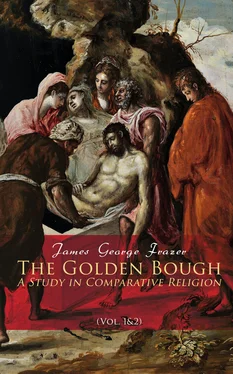But when it is necessary to cut the hair, precautions are taken to lessen the dangers which are supposed to attend the operation. Amongst the Maoris many spells were uttered at hair-cutting; one, for example, was spoken to consecrate the obsidian knife with which the hair was cut; another was pronounced to avert the thunder and lightning which hair-cutting was believed to cause.693 “He who has had his hair cut is in the immediate charge of the Atua (spirit); he is removed from the contact and society of his family and his tribe; he dare not touch his food himself; it is put into his mouth by another person; nor can he for some days resume his accustomed occupations or associate with his fellow men.”694 The person who cuts the hair is also tabooed; his hands having been in contact with a sacred head, he may not touch food with them or engage in any other employment; he is fed by another person with food cooked over a sacred fire. He cannot be released from the taboo before the following day, when he rubs his hands with potato or fern root which has been cooked on a sacred fire; and this food having been taken to the head of the family in the female line and eaten by her, his hands are freed from the taboo. In some parts of New Zealand the most sacred day of the year was that appointed for hair-cutting; the people assembled in large numbers on that day from all the neighbourhood.695 It is an affair of state when the king of Cambodia's hair is cut. The priests place on the barber's fingers certain old rings set with large stones, which are supposed to contain spirits favourable to the kings, and during the operation the Brahmans keep up a noisy music to drive away the evil spirits.696 The hair and nails of the Mikado could only be cut while he was asleep,697 perhaps because his soul being then absent from his body, there was less chance of injuring it with the shears.
But even when the hair and nails have been safely cut, there remains the difficulty of disposing of them, for their owner believes himself liable to suffer from any harm that may befall them. Thus, an Australian girl, sick of a fever, attributed her illness to the fact that some months before a young man had come behind her and cut off a lock of her hair; she was sure he had buried it and that it was rotting. “Her hair,” she said, “was rotting somewhere, and her Marm-bu-la (kidney fat) was wasting away, and when her hair had completely rotted, she would die.”698 A Marquesan chief told Lieutenant Gamble that he was extremely ill, the Happah tribe having stolen a lock of his hair and buried it in a plantain leaf for the purpose of taking his life. Lieut. Gamble argued with him, but in vain; die he must unless the hair and the plantain leaf were brought back to him; and to obtain them he had offered the Happahs the greater part of his property. He complained of excessive pain in the head, breast and sides.699 When an Australian blackfellow wishes to get rid of his wife, he cuts off a lock of her hair in her sleep, ties it to his spear-thrower, and goes with it to a neighbouring tribe, where he gives it to a friend. His friend sticks the spear-thrower up every night before the camp fire, and when it falls down it is a sign that his wife is dead.700 The way in which the charm operates was explained to Mr. Howitt by a Mirajuri man. “You see,” he said, “when a blackfellow doctor gets hold of something belonging to a man and roasts it with things, and sings over it, the fire catches hold of the smell of the man, and that settles the poor fellow.”701 In Germany it is a common notion that if birds find a person's cut hair, and build their nests with it, the person will suffer from headache;702 sometimes it is thought that he will have an eruption on the head.703 Again it is thought that cut or combed out hair may disturb the weather by producing rain and hail, thunder and lightning. We have seen that in New Zealand a spell was uttered at hair-cutting to avert thunder and lightning. In the Tirol, witches are supposed to use cut or combed out hair to make hail-stones or thunder-storms with.704 Thlinket Indians have been known to attribute stormy weather to the fact that a girl had combed her hair outside of the house.705 The Romans seem to have held similar views, for it was a maxim with them that no one on shipboard should cut his hair or nails except in a storm,706 that is, when the mischief was already done. In West Africa, when the Mani of Chitombe or Jumba died, the people used to run in crowds to the corpse and tear out his hair, teeth, and nails, which they kept as a rain-charm, believing that otherwise no rain would fall. The Makoko of Anzikos begged the missionaries to give him half their beards as a rain-charm.707 In some Victorian tribes the sorcerer used to burn human hair in time of drought; it was never burned at other times for fear of causing a deluge of rain. Also when the river was low, the sorcerer would place human hair in the stream to increase the supply of water.708
To preserve the cut hair and nails from injury and from the dangerous uses to which they may be put by sorcerers, it is necessary to deposit them in some safe place. Hence the natives of the Maldives carefully keep the cuttings of their hair and nails and bury them, with a little water, in the cemeteries; “for they would not for the world tread upon them nor cast them in the fire, for they say that they are part of their body and demand burial as it does; and, indeed, they fold them neatly in cotton; and most of them like to be shaved at the gates of temples and mosques.”709 In New Zealand the severed hair was deposited on some sacred spot of ground “to protect it from being touched accidentally or designedly by any one.”710 The shorn locks of a chief were gathered with much care and placed in an adjoining cemetery.711 The Tahitians buried the cuttings of their hair at the temples.712 The cut hair and nails of the Flamen Dialis were buried under a lucky tree.713 The hair of the Vestal virgins was hung upon an ancient lotus-tree.714 In Germany the clippings of hair used often to be buried under an elder-bush.715 In Oldenburg cut hair and nails are wrapt in a cloth which is deposited in a hole in an elder-tree three days before the new moon; the hole is then plugged up.716 In the West of Northumberland it is thought that if the first parings of a child's nails are buried under an ash-tree, the child will turn out a fine singer.717 In Amboina before a child may taste sago-pap for the first time, the father cuts off a lock of the child's hair which he buries under a sago palm.718 In the Aru Islands, when a child is able to run alone, a female relation cuts off a lock of its hair and deposits it on a banana-tree.719 In the island of Roti it is thought that the first hair which a child gets is not his own and that, if it is not cut off, it will make him weak and ill. Hence, when the child is about a month old, his hair is cut off with much ceremony. As each of the friends who are invited to the ceremony enters the house he goes up to the child, cuts off a little of its hair and drops it into a cocoa-nut shell full of water. Afterwards the father or another relation takes the hair and packs it into a little bag made of leaves, which he fastens to the top of a palm-tree. Then he gives the leaves of the palm a good shaking, climbs down, and goes home without speaking to any one.720 Indians of the Yukon territory, Alaska, do not throw away their cut hair and nails, but tie them up in little bundles and place them in the crotches of trees or anywhere where they will not be disturbed by animals. For “they have a superstition that disease will follow the disturbance of such remains by animals.”721 The clipped hair and nails are often buried in any secret place, not necessarily in a temple or cemetery or under a tree, as in the cases already mentioned. In Swabia it is said that cut hair should be buried in a place where neither sun nor moon shines, therefore in the ground, under a stone, etc.722 In Danzig it is buried in a bag under the threshold.723 In Ugi, one of the Solomon Islands, men bury their hair lest it should fall into the hands of an enemy who would make magic with it and so bring sickness or calamity on them.724 The Zend Avesta directs that the clippings of hair and the parings of nails shall be placed in separate holes, and that three, six, or nine furrows shall be drawn round each hole with a metal knife.725 In the Grihya-Sûtras it is provided that the hair cut from a child's head at the end of the first, third, fifth, or seventh year shall be buried in the earth at a place covered with grass or in the neighbourhood of water.726 The Madi or Moru tribe of Central Africa bury the parings of their nails in the ground.727 The Kafirs carry still further this dread of allowing any portion of themselves to fall into the hands of an enemy; for not only do they bury their cut hair and nails in a sacred place, but when one of them cleans the head of another he preserves the insects which he finds, “carefully delivering them to the person to whom they originally appertained, supposing, according to their theory, that as they derived their support from the blood of the man from whom they were taken, should they be killed by another the blood of his neighbour would be in his possession, thus placing in his hands the power of some superhuman influence.”728 Amongst the Wanyoro of Central Africa all cuttings of the hair and nails are carefully stored under the bed and afterwards strewed about among the tall grass.729 In North Guinea they are carefully hidden (it is not said where) “in order that they may not be used as a fetish for the destruction of him to whom they belong.”730 In Bolang Mongondo (Celebes) the first hair cut from a child's head is kept in a young cocoa-nut, which is commonly hung on the front of the house, under the roof.731
Читать дальше












